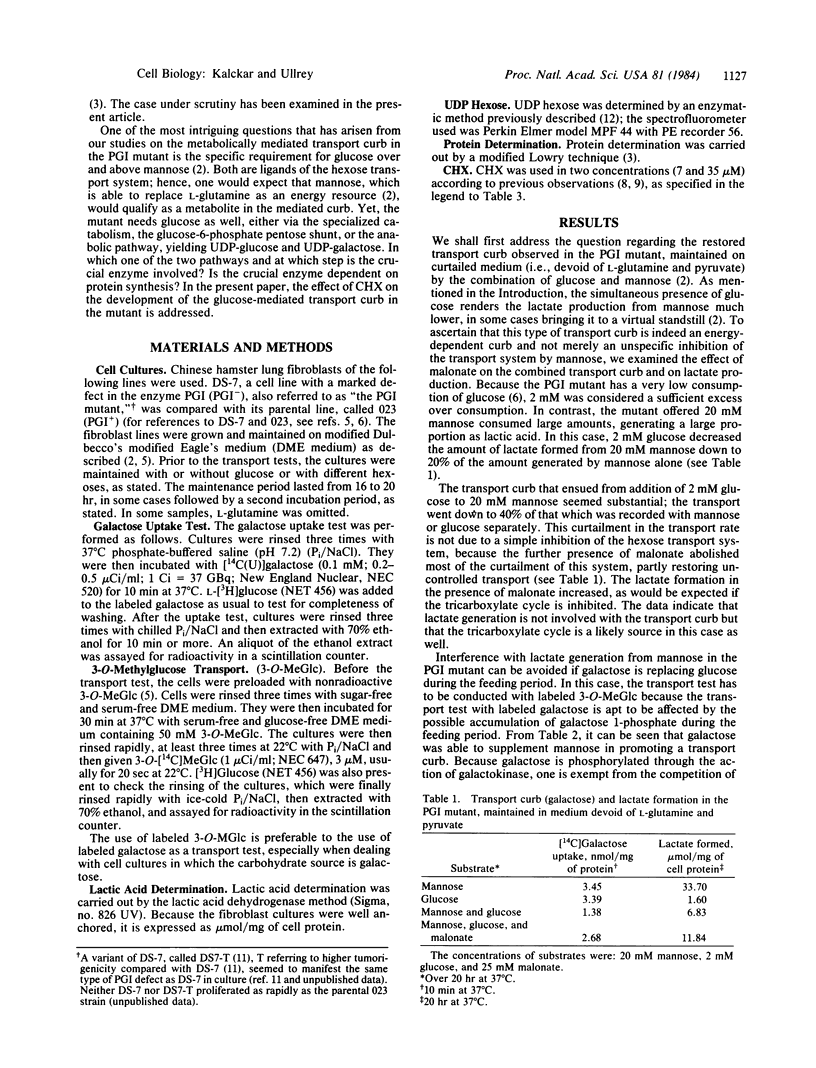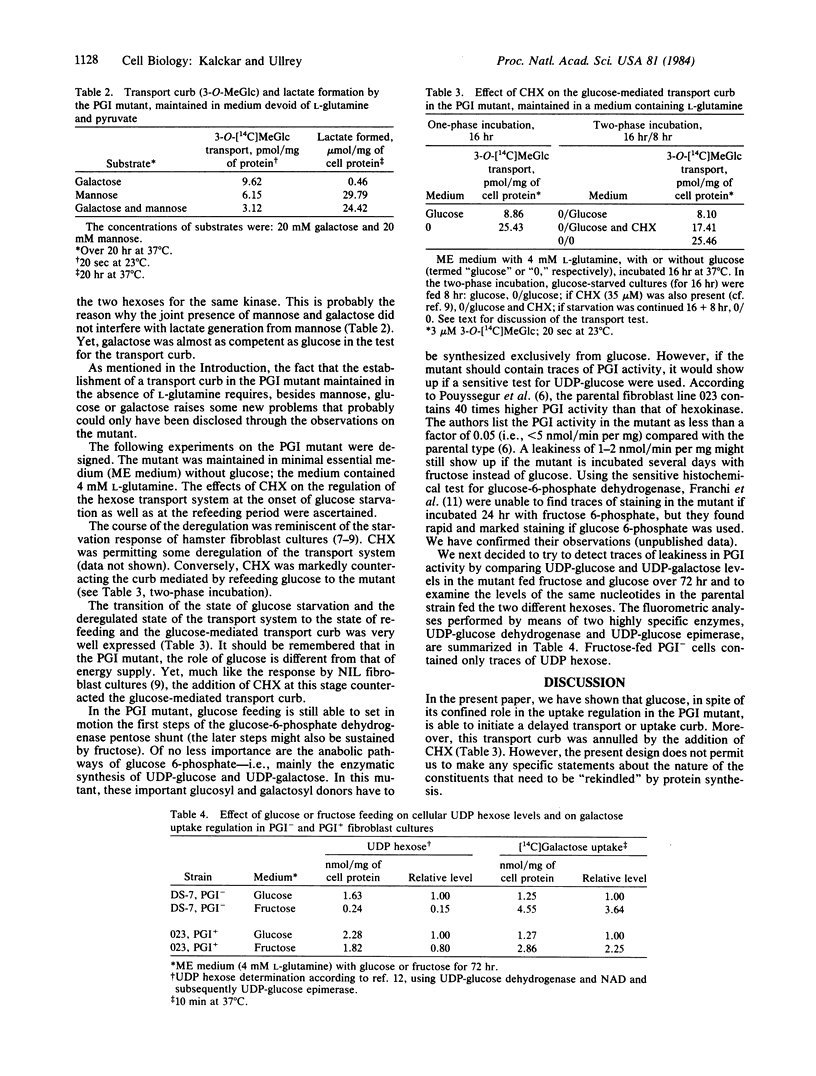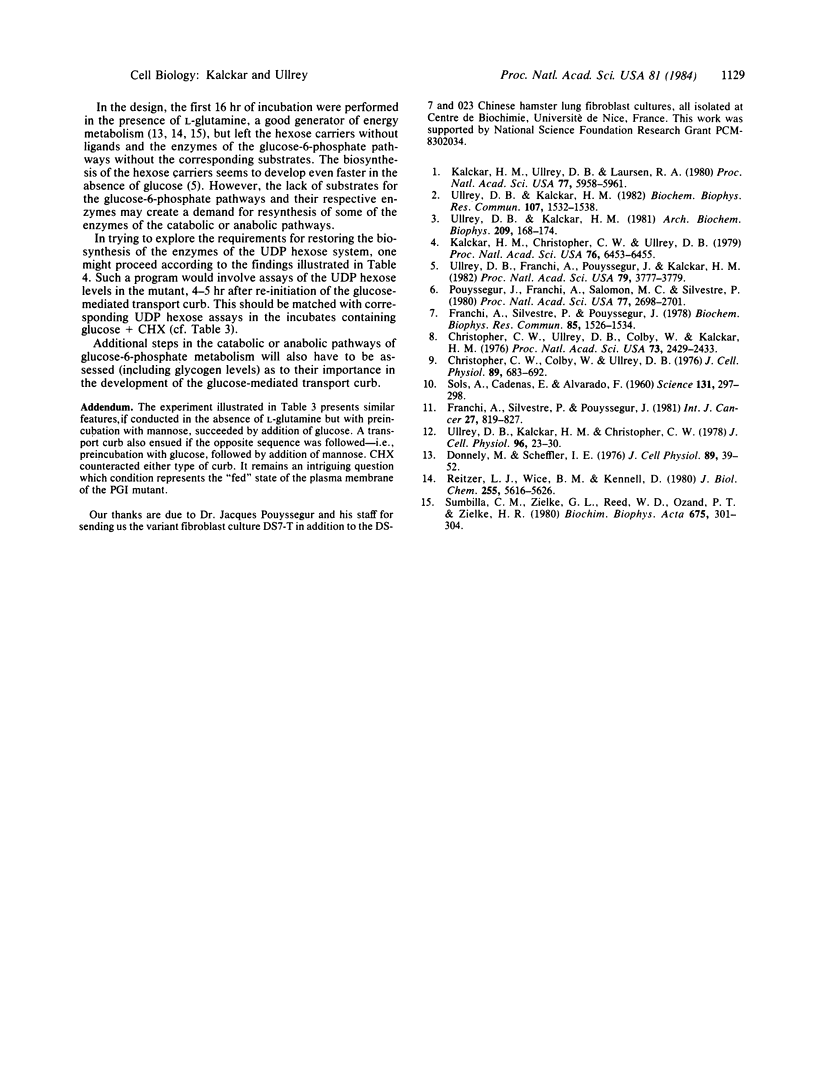Abstract
A close study of the metabolic regulation of hexose transport in a hamster fibroblast mutant, highly defective in the enzyme phosphoglucose isomerase (PGI mutant), reveals the requirement for at least three vectors for transport regulation. The downward regulation of the hexose transport system, called the "transport curb," requires (i) a ligand for the transport system, (ii) oxidative energy metabolism, and (iii) some specific enzymes of the glucose-6-phosphate metabolism. Deprivation of glucose was shown to deprive the PGI mutant of UDP hexose, whereas the glucose-fed mutant contained high levels. The parental strain preserved the UDP hexose with or without glucose feeding. Cycloheximide added to the mutant showed two different types of effects. If added at the onset of glucose starvation, the up-regulation of the transport system was scarcely affected. If cycloheximide was added to the mutant at the onset of glucose refeeding, it prevented the development of the glucose-mediated transport curb. In the mutant, the glucose-mediated curb is not derived from energy metabolism but is solely dependent on certain enzymes of glucose-6-phosphate metabolism. The interference of this curb by cycloheximide requires evidently a reassessment, including that of the role of the UDP hexose pathway in regulation of the hexose transport system.
Full text
PDF



Selected References
These references are in PubMed. This may not be the complete list of references from this article.
- Christopher C. W., Colby W. W., Ullrey D. Derepression and carrier turnover: evidence for two distinct mechanisms of hexose transport regulation in animal cells. J Cell Physiol. 1976 Dec;89(4):683–692. doi: 10.1002/jcp.1040890427. [DOI] [PubMed] [Google Scholar]
- Christopher C. W., Ullrey D., Colby W., Kalckar M. Paradoxical effects of cycloheximide and cytochalasin B on hamster cell hexose uptake. Proc Natl Acad Sci U S A. 1976 Jul;73(7):2429–2433. doi: 10.1073/pnas.73.7.2429. [DOI] [PMC free article] [PubMed] [Google Scholar]
- Donnelly M., Scheffler I. E. Energy metabolism in respiration-deficient and wild type Chinese hamster fibroblasts in culture. J Cell Physiol. 1976 Sep;89(1):39–51. doi: 10.1002/jcp.1040890105. [DOI] [PubMed] [Google Scholar]
- Franchi A., Silvestre P., Pouyssegur J. "Carrier activation" and glucose transport in Chinese hamster fibroblasts. Biochem Biophys Res Commun. 1978 Dec 29;85(4):1526–1534. doi: 10.1016/0006-291x(78)91176-2. [DOI] [PubMed] [Google Scholar]
- Franchi A., Silvestre P., Pouysségur J. A genetic approach to the role of energy metabolism in the growth of tumor cells: tumorigenicity of fibroblast mutants deficient either in glycolysis or in respiration. Int J Cancer. 1981 Jun 15;27(6):819–827. doi: 10.1002/ijc.2910270614. [DOI] [PubMed] [Google Scholar]
- Kalckar H. M., Christopher C. W., Ullrey D. Uncouplers of oxidative phosphorylation promote derepression of the hexose transport system in cultures of hamster cells. Proc Natl Acad Sci U S A. 1979 Dec;76(12):6453–6455. doi: 10.1073/pnas.76.12.6453. [DOI] [PMC free article] [PubMed] [Google Scholar]
- Kalckar H. M., Ullrey D. B., Laursen R. A. Effects of combined glutamine and serum deprivation on glucose control of hexose transport in mammalian fibroblast cultures. Proc Natl Acad Sci U S A. 1980 Oct;77(10):5958–5961. doi: 10.1073/pnas.77.10.5958. [DOI] [PMC free article] [PubMed] [Google Scholar]
- Pouysségur J., Franchi A., Salomon J. C., Silvestre P. Isolation of a Chinese hamster fibroblast mutant defective in hexose transport and aerobic glycolysis: its use to dissect the malignant phenotype. Proc Natl Acad Sci U S A. 1980 May;77(5):2698–2701. doi: 10.1073/pnas.77.5.2698. [DOI] [PMC free article] [PubMed] [Google Scholar]
- Reitzer L. J., Wice B. M., Kennell D. The pentose cycle. Control and essential function in HeLa cell nucleic acid synthesis. J Biol Chem. 1980 Jun 25;255(12):5616–5626. [PubMed] [Google Scholar]
- SOLS A., CADENAS E., ALVARADO F. Enzymatic basis of mannose toxicity in honey bees. Science. 1960 Jan 29;131(3396):297–298. doi: 10.1126/science.131.3396.297. [DOI] [PubMed] [Google Scholar]
- Sumbilla C. M., Zielke C. L., Reed W. D., Ozand P. T., Zielke H. R. Comparison of the oxidation of glutamine, glucose, ketone bodies and fatty acids by human diploid fibroblasts. Biochim Biophys Acta. 1981 Jul;675(2):301–304. doi: 10.1016/0304-4165(81)90242-7. [DOI] [PubMed] [Google Scholar]
- Ullrey D. B., Franchi A., Pouyssegur J., Kalckar H. M. Down-regulation of the hexose transport system: metabolic basis studied with a fibroblast mutant lacking phosphoglucose isomerase. Proc Natl Acad Sci U S A. 1982 Jun;79(12):3777–3779. doi: 10.1073/pnas.79.12.3777. [DOI] [PMC free article] [PubMed] [Google Scholar]
- Ullrey D. B., Kalckar H. M., Christopher C. W. Further observations on metabolic responses in hamster cells: changes in UDPG dehydrogenase activity. J Cell Physiol. 1978 Jul;96(1):23–30. doi: 10.1002/jcp.1040960104. [DOI] [PubMed] [Google Scholar]
- Ullrey D. B., Kalckar H. M. Schism and complementation of hexose-mediated transport regulation as illustrated in a fibroblast mutant lacking phosphoglucose-isomerase. Biochem Biophys Res Commun. 1982 Aug 31;107(4):1532–1538. doi: 10.1016/s0006-291x(82)80173-3. [DOI] [PubMed] [Google Scholar]
- Ullrey D. B., Kalckar H. M. The nature of regulation of hexose transport in cultured mammalian fibroblasts: aerobic "repressive" control by D-glucosamine. Arch Biochem Biophys. 1981 Jun;209(1):168–174. doi: 10.1016/0003-9861(81)90269-1. [DOI] [PubMed] [Google Scholar]


